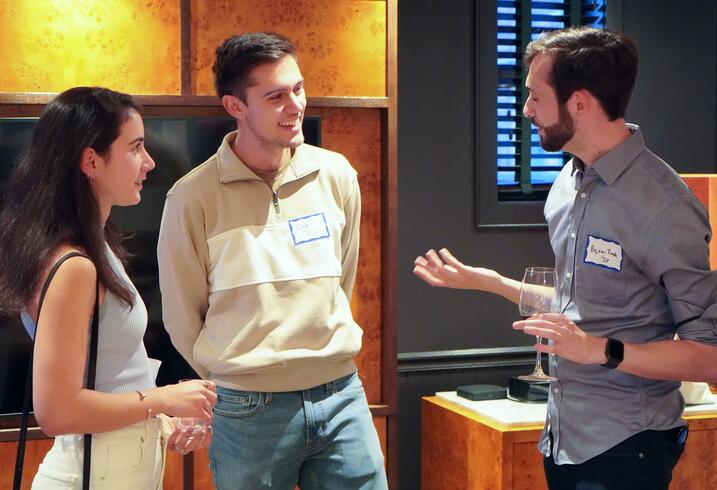Honors College Day 5: Exploring the Past and Planning for Our Future
Honors College Day 5: Exploring the Past and Planning for Our Future
This is the fifth and final story in a series of blog posts written by the Fisher Family Honors Program class of 2023 detailing their experiences in Washington, D.C. for CDDRL's annual Honors College.

To round out our trip to Washington, the CDDRL Honors cohort was taken on a private tour of the National Museum of African American History and Culture (aka the Blacksonian) before it opened. Given that it’s very difficult to acquire tickets to the museum, it was a true privilege to be able to get a tour, led by a volunteer. Part of the reason this visit was so special was our tour guide, an African-American woman, who had spent her first years under segregation. Hearing her firsthand stories about the racial divide that was so fiercely pursued in Southern states added a personal layer to the historical atrocities that all of us had heard about. To that end, my favorite exhibit in the museum was on Reconstruction and Jim Crow, during which African-Americans were systematically excluded from American democracy and one-party rule proliferated across the South. The somber depiction of the fear tactics used against African-Americans trying to exercise their constitutional rights reinforced to me how fragile democracy in America has been in the past, despite the traditional narrative of the “city on the hill.” Given that many of us are writing about democracy in our theses, I think it was important to visit a place that adds nuance to that narrative.

In the afternoon, we joined Ben Chao, a CISAC Honors Program alumnus, for a tour of the US Capitol. As we walked through the various buildings in the complex, he pointed out the details that incorporated American history in the building’s design. From the Old Supreme Court Chamber to the Rotunda paintings, we could track the political and historical development of the country through the design choices and depicted scenes. In one of the paintings, we saw the damage done during the US Capitol Attack on Jan. 6, 2021 — reminding us of its lasting impact on people working in the building.





At the end of the tour, more Stanford alums joined Ben to host a panel about working on The Hill. In one hour, we got to hear a perspective from journalists, legislative assistants, policy advisors, legislative directors, and chiefs of staff. We really enjoyed the diversity of positions represented, since they complemented each other’s descriptions of working in DC and illustrated the various paths available after graduation. After a short break, we went to the last event of the program — a networking event with Honors Alumni. After talking with alumni about their thesis process and experience after graduation, we got a glimpse of the year ahead. Their encouragement and support have energized all of us to continue working and getting to know the CDDRL community.
~ Anastasiia Malenko and Sean Michael










Though the whole trip had been filled with awesome connections with think tanks, researchers, and practitioners who had been in the government space for years, one thing all of us looked forward to was speaking with people who were closer in their careers to us and who worked directly in the brunt of all these issues. For this reason, Friday’s Capitol Hill discussion panel with Stanford alums was eagerly awaited.
Before our stop at Capitol Hill, our cohort was lucky to have an exceptional treat of privately touring the African American Museum before the building opened. Though I had been before, it had been under remarkably different circumstances. About three and a half years earlier I visited the museum with my high school on our senior trip. I went to a high school that did not largely reflect the diversity of my state or country. Additionally, what I learned in high school unfortunately did not include much of African American history — from both the tribulations of enslaved people to the cultural contributions of African Americans to American society. The last time I visited I was essentially exposed to many of these concepts for the first time. Now, almost four years later, I’ve learned about American history from a significantly more critical position, while also simultaneously being exposed to peers who are directly affected by the systematic discrimination of African Americans. Visiting this museum again, in the wake of a week of learning about the weakening of American democratic institutions, put American history into a new context. I couldn’t help but think as I was in the museum, of course it makes sense that our democratic institutions are backsliding — they were never truly democratic in the first place!

The museum was followed by our trip to Capitol Hill. Learning from recent Stanford alums about their experiences navigating the DC world was fascinating. A big takeaway I had was that so much elevation in this world is based on connections. From what I gathered though was that these connections were often genuine, and networking, people-using types did not do as well in Washington as popular consensus would have us believe. Another interesting part of the discussions was hearing about how January 6th and COVID have changed aspects of the policymaking process — specifically by limiting external lobbying pressures and affecting the relationships between other parties' offices.
We finished up the day with a networking event with CDDRL alums who lived in the area. It was an awesome chance to blow off some steam, talk more about the thesis process specifically, and compare stories from our times at Stanford. It also showed us how far our cohort had come in terms of bonding!
~ Alison Cohen



































